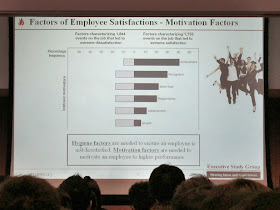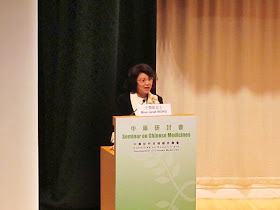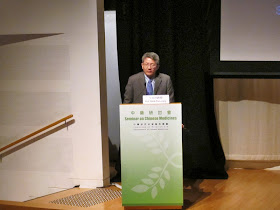The Seminar on Chinese Medicines was organized by the Committee on Research and Development of Chinese Medicines (CRDCM) and co-organized by the Deprtment of Health (DoH), Hospital Authority (HA) and Hong Kong Council for Testing and Certification (HKCTC), as well as, supported by Hong Kong Science and Technology Parks (HKSTP) on 14 September 2012. The Committee on Research and Development of Chinese Medicines (CRDCM) formed under the Innovation and Technology Commission (ITC) held its first meeting on 21st December 2011. The Committee has replaced the Hong Kong Jockey Club Institute of Chinese Medicine Limited as the platform for the Government to solicit views on how best to support research and development, testing and promotion of Chinese medicine development in Hong Kong. It is the first seminar organized by CRDCM. I would like to summarize the seminar below for sharing.

In the beginning, Ms. Janet WONG (Chairperson, CRDCM and Commissioner for Innovation and Technology) gave a welcoming remarks. She said that the cooperation among Government, Industries, Universities and Research Institutes were important. Moreover, Innovation & Technology Fund (ITF) was increased the ceiling upto HK$30M.
Then, Dr. Constance Chan (Director of Health, Department of Health) gave a welcoming speech.
Dr. LO Su-vui (Director (Strategy & Planning), Hospital Authority gave a welcoming speech too. Dr. Lo said East and West treatment method could be cooperated.
Souvenir Presentation and group photo with supporters
Souvenir Presentation and group photo with speakers
The first speaker was Dr. Ronald LAM (Assistant Director (Traditional Chinese Medicine), Department of Health) and his topic entitled "Development of regulatory regime for Chinese medicines in Hong Kong - the latest update".
Dr. Lam briefed the usage of Chinese Medicine in Hong Kong that 28.3% in Public Sector and 71.7% in Private Sector. Then he introduced the history of Chinese Medicine Ordinance which established on 13 Sep 1999. After that the regulation of Chinese Medicines were mentioned including Import/Export Control, Licensing of CM traders, GMP requirement, registration of proprietary CM and package, as well as post market surveillance. Promotion of CM development involved "Strengthen control on CM quality and safety", "Enhance international competitiveness of CM industry", "Modernize CM" and "Integrate CM into health care system".
The second speaker was Prof. Joseph SUNG (Vice-Chancellor and President, The Chinese University of Hong Kong) and his presentation was "Integrative medicine". He questioned “Is there a need to combine Western and Chinese Medicine? and Is there a scientific basis to combine Western and Chinese Medicine?” in the beginning of his talk.
Then Prof. Sung described different researches in the world included "Acupuncture & Osteoarthritis", "Gingko for Dementia", "Tai Chi and Fall", "Cancer and Chinese medicine", "TCM and Chronic Hepatitis B".
The advantages of combining Western and Chinese Medicine Practice were shown as follows.
- fewer side effects
- high acceptance for Chinese medicine
- Good clinical evdence for the efficacy in some areas (e.g. pain relief, dementia & fall).
The he introduced the Integrative Medical Clinic: Model of care.
Prof. So Kwok-fai (Jessie Ho Professorship in Neuroscience, and Chair Professor, Department of Anatomy, Li Ka Shing Faculty of Medicine, The University of Hong Kong) was the third speaker and his presentation title named "Bringing modernised Chinese medicines from bench side to bed side, using Gouqizi as an example".
Prof. So briefed the CM research and development. He focused on Gouqizi functions and chemical composition (e.g. β-carotene, Betaine, Zeaxanthin, etc.) Recently, they had studying the topic "Randomized control trial on the neuroprotective effects of oral Lycium Barbarum polysaccharides supplement in the treatment of normal tension glaucoma".
Prof. LU Aiping (Dean, School of Chinese Medicine, Hong Kong Baptist University) was the fourth speaker and his topic entitled "Chinese medicine in China".
Prof. Lu introduced the 12th Five-year Plan in which mentioned new layout for Chinese Medicine included in WHO ICD-11 and ISO. Then he briefed the basic statistics on Education and Clinical Trials. The following diagram showed the funding variation between the 11th and 12th Five-year plan.
The fifth speaker was Prof. TANG Xudong (Director, Xi Yuan Hospital of China Academy of Chinese Medical Sciences) and he presented the topic "The challenge of developing Phase I Clinical Trial Center for Chinese medicines". Good Clinical Research Practice (GCP) platform was mentioned.
The sixth speaker was Prof. LIU Liang (Vice Rector, Macau University of Science and Technology) and his topic named "Synthesizing multiple cutting-age technologies for quality research of Chinese medicines and innovative drug screening".
The seventh speaker was Dr. Eric ZIEA (Chief (Chinese Medicine and Integrative Medicine), Hospital Authority) and his topic entitled "The work of the Hospital Authority relating to Chinese medicine".
Dr. Ziea said that objectives of CM Service are to promote the development of "evidence-based" CM practice through clinical research and to systematize the knowledge base of CM. The future 3-year plan was mentioned.
The eighth speaker was Dr. GUO Ruoling (Associate Director, TCM Lead, Asia Pacific R&D,Sanofi) and his presentation was "The benefits of industry-academia collaboration in R&D of innovative TCM products". Dr. Guo concluded that collaboration was the efficient way to move forward in innovation of TCM and which was not limited to Industrial-academia and regional areas collaboration.
Mr. Dominic LAM (Member, Hong Kong Council for Testing and Certification) was the ninth speaker and his presentation title named "Testing and certification of Chinese medicines in Hong Kong".
Mr. Lam mentioned the important of quality control in chinese medicines and briefed different testing methodologies such as TLC and HPLC. Finally, he summarized different requirements from herbal medicine (GAP) to Production (PIC/S GMP) to Product (Quality specification).
Theme: Chinese Herbal Medicine
Prof. Albert LEUNG (Director, School of Chinese Medicine, The Chinese University of Hong Kong) was the session chair.
Dr. XU Min (Assistant Professor (Teaching Division), School of Chinese Medicine, Hong Kong Baptist University) was the tenth speaker and his topic entitled "Systematic review of traditional herbal formulae for the treatment of common chronic diseases".
Dr. Xu explained the project objective that they performed systematic reviews and meta-analyses on Traditional herbal Formula (TF) in the treatment of ten chronic diseases including hypertension, coronary artery disease, stroke, chronic obstructive pulmonary disease, liver cancer, liver fibrosis, diabetes mellitus, rheumatoid arthritis, depression and eczema.
The eleventh speaker was Prof. BIAN Zhao-xiang (Associate Dean and Director of Clinical Division, Shool of Chinese Medicine, Hong Kong Baptist University) and he presented the topic "Evidence based management HBV and its liver complications using Chinese herbal medicine: Challenges ahead". He said the current fashion in medical research was RCTism. An ideal approach was RCT-SR-Practice which was from Meta-analysis to Systematic Review to Randomized Controlled Trial and the last was Good Clinical Practice.
The twelfth speaker was Dr. FENG Yi-bin (Assistant Director (Education), School of Chinese Medicine, The University of Hong Kong) and his topic named "Effectiveness of Chinese hearbal medicine in treating liver fibrosis: a systematic review and meta-analysis of randomized controlled trials".
Many experimental and clinical studies investigating the potential efficacy of Chinese medicine on liver fibrosis had been published and reported the positive effect in using Chinese medicines.
Theme: Acupuncture
Prof. LU Aiping (Dean, School of Chinese Medicine, Hong Kong Baptist University) was the session chair.
Dr. CHUNG Ka-fai (Clinical Associate Professor, Department for Psychiatry, The University of Hong Kong) was the thirteenth speaker and his topic entitled "Prevention and treatment for insomnia using acupuncture and/or Chinese herbal medicine". Dr. Chung concluded that electroacupuncture and minimal acupuncture were more effective than placebo acupuncture in treating insomnia and adverse events related to acupuncture were mild in severity.
The fourteenth speaker was Dr. SUI Yi (Research Associate, Asia Diabetes Foundation) and he presented the topic "A systematic review on use of Chinese medicine and acupuncture for treatment of obesity". TCM of Chinese herbal medicine (CHM) and acupuncture were widely used to control body weight and the research aimed to examine the efficacy, safety, rationale and incidence of relapse of weight gain using TCM to treat obesity.
The Fifteenth speaker was Dr. ZHANG Zhang-jin (Assistant Director (Clinical Affairs), School of Chinese Medicine, The University of Hong Kong) and his topic named "Dense cranial electroacupuncture stimulation for neuropsychiatric disorders: rationale and clinical application".
A collection of the activated neural and neuroactive components distributed in the skin, muscle, and connective tissues surrounding the inserted needle were defined as a neural acupuncture unit (NAU). Dr. Zhang concluded that dense cranial electroacupuncture stimulation (DCEAS) was effective in reducing Obsessive-Compulsive Disorder (OCD), depression and insomnia symptoms.
Theme: Herb-Drug interaction, Qi-Gong and Taichi, Clinical Trial
Prof. TONG Yao (Director, School of Chinese Medicine, The University of Hong Kong) was the session chair.
Prof. Joan ZUO (School of Pharmacy, The Chinese University of Hong Kong) was the sixteenth speaker and his topic entitled "Studies of herb-drug interaction involving Oseltamivir and Chinese medicine formulae". Her research found that Chinese medicine formulae (CMF1) demonstrated potential antiviral activity.
The Seventeenth speaker was Prof. Cecilia CHAN (Centre on Behavioral Health, The University of Hong Kong) and he presented the topic "Use of Chinese Qi-Gong in prevention and rehabilitation ". The research aimed to assess the efficacy of the Qigong exercise on physiological, psychological well-being, and quality of life for the adult chronic fatigue syndrome (CFS) patients in Hong Kong. It was found that the optimal dosage was more than 3 times per week and at least 30 minutes per time.

The last speaker was Dr. Vincent CHUNG (Assistant Professor, The Jockey Club School of Public Health and Primary Care, The Chinese University of Hong Kong) and his topic named "Evaluating effectiveness of Chinese medicine treatment from patients’ perspective". Patient reported outcomes (PROs) use was particularly common for products developed to treat chronic, disabling conditions where the intention was not necessarily to cure but to ameliorate symptoms, facilitate functioning, or improve quality of life.
At the end, Ms. Janet WONG gave a closing remark.
Reference:
The terms of Reference on the Committee on Research and Development of Chinese Medicines (CRDCM) -
http://gia.info.gov.hk/general/201112/21/P201112210381_0381_88310.pdf
HKCTC -
http://www.hkctc.gov.hk/en/about.html
Department of Health -
http://www.dh.gov.hk/eindex.html
Hospital Authority -
http://www.ha.org.hk/visitor/ha_index.asp?Lang=CHIB5
HKSTP -
http://www.hkstp.org/HKSTPC/en_html/en_index.jsp














































































